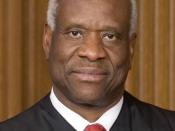Legal Brief Case: Right to Confront: Coy V Iowa.
Date: August 2,1985.
Principals:(main characters) *Kathy Brown (13) *Linda Thompson (friend) (13) *girls names were changed to protect identities.
-intruder believed to be John Avery Coy, (34).
Facts of the Case: Kathy Brown invited her friend Linda to come and sleep over.
Kathy made a makeshift tent out in her backyard.
Girls fell asleep between 10:30 and 11:00 pm.
In the middle of the night Kathy saw a hand pull back one of the blankets from over the table.
Man (who she thought was her father) crawled into the tent carrying a small white bag.
Man grabbed Kathy and Linda by the throat and threatened "If you scream, I'll knock you out." He ordered the girls to from their sleeping bags and to take off all of their clothes but their underwear.
He warned them not to scream or he will hurt them not kill them.
He ordered them to lay back down and he kissed them and fondled with their breasts.
He ordered to remove their underwear and lay back down.
He put their underwear in his white bag and told the girls to kiss each other.
The man took off his pants and made the girls fondle his penis and put it into their mouths.
The assault lasted over an hour and a half.
He ordered the girls to lay naked on their stomachs.
He then layed down between them and discussed his plan to exit.
Stroked the girls, and warned them that if they told anyone that they would go through a terrible ordeal with a lot of people and the police.
He then tied Kathy's arms behind her back with her sweatshirt and then did the same to Linda.
He gathered his things and the white bag with their panties in it, the black and red flashlight brought to the tent by Kathy, a yellow plastic cup with white interior that he used.
He told the girls not to move because he would be back in two minutes.
They did so in fear of him although he never returned.
Plaintiff's Position: On November 7, 1985 there was a pre-trial in which Gary Rolfes requested that the girl witnesses be allowed to testify via closed- circuit television in a room adjacent to the courtroom. Rolfes proposed the judge, attorneys, witnesses, and Coy be in the adjacent with a screen placed between the witnesses and Coy. Then the girl's testimony would be wired back into the courtroom and the jury could watch on monitor. The reasoning for this request is fear altogether and of seeing the guy again and bringing bad thoughts back. It would make it easier for them meaning the girls to talk about the touchy subject. For a while they feared going anywhere near the courthouse or even talk to anyone about what happened.
Defendant's Position: Jack Wolfe the defendants lawyer objected that the procedure would give the overwhelming impression that Coy was guilty, and it would be eroding his constitutional right to the presumption of innocence. Also that it violated Coy's sixth amendment right to be confronted with the witnesses against him. And the fact that such protective devices made no sense in Coy's case because the girls could not identify him as the assailant.
The judge over ruled Wolfe's objections. He said that the girls should testify in the courtroom but they could use a screen. His reasoning was that they jury could get a first hand look at the witnesses and Coy during the testimony. The girls would not be able to see Coy but Coy would be able to see them.
Balancing Act: Personally I think that the girls should have the right to have the screen blocking their view of seeing the defendant. If they didn't have the screen there then the girls would not of talked and told their side of the story. Like I previously said they would not say a single word to anyone about what happened even their parents. Then as time progressed they started talking about it little pieces at a time, then telling their story and seeing a lawyer. If they did not have that screen then they would not of been able to talk. I mean if Coy got to see the girls face to face when they were talking he would or could do many things to them to make them feel uncomfortable and scared and to freeze and not be able to continue unless his hands were cuffed. If they were not cuffed then he could make hand gestures to harass them like zip your mouth. He could mouth words to them that could be threatening and all the last thing the girls needed was to go through more trauma.
As for Coy he also has the right under the sixth amendment to be confronted with witnesses against him. He is probably intimidating the girls. I think it would be different if it was two adults, they are older and more mature. But these are two young girls and one middle aged man who may of scared them for life.
Related Cases: Maryland V. Craig 497 U.S. 836.
Court: Supreme Court of United States.
Year of Decision: 1990 Child Abuse/ Child Witnesses A childcare provider was convicted of sexually abusing children in her care. The trial judge was required to determine if the testimony by the child having direct confrontation with the defendant would cause serious emotional distress making it so the child could not reasonably communicate. The Maryland Supreme Court overturned the conviction on the ground that the court failed to adequately justify its decision to allow a child witness to testify via one-way closed- circuit video in violation of the defendants right to confront his accuser.
APA Position: The APA's brief argues that: (1) sexually abused children frequently suffer serious emotional trauma and may be particularly vulnerable to further distress through the legal process, since child victims suffer emotional distress as a result of their victimization and child victims may be more likely than adult victims to suffer substantial distress as a result of testifying in the physical presence of the defendant; (2) psychological theory and data about the dynamics of sexual abuse victims' emotional distress make possible individualized determinations about the need for protective measures without requiring vulnerable children to directly confront their alleged abusers in every case; and (3) if a vulnerable child victims witness is required to testify under conditions of high emotional arousal the confrontation clause interest of providing reliable testimony will not be served because the completeness of the children's testimony is influenced by conditions of emotional arousal and a child witness's lack of completeness in testifying influences juror perceptions of creditability, but does not necessarily enhance the accuracy of juror perceptions of truthfulness of lying. (www.psyclaw.org/maryland.html) The US Supreme Court held that it did not violate a defendant's right to confront his accusers if, prior to permitting indirect testimony, the court made a particularized finding that the individual child witness would be traumatized by testifying in the presence of the defendant. (www.psyclaw.org/maryland.html) Disposition: (What happened?) On November 7, 1985 a pretrial was held where Gary Rolfes requested that the girls be allowed to testify via closed- circuit television in a room adjacent to the courtroom.
The trial began on November 14, 1985. On November 19, 1985 the jury returned with a verdict of guilty of two counts of lascivious acts with a child. The judge gave the harshest allowed by the Iowa law. Coy was sentenced to maximum prison term for each account of five years and ordered that they served consecutively.
Coy appealed to the Iowa Supreme Court. The sixth amendment guaranteed him a right to "confront the witnesses against him", wasn't a physical barrier between the witnesses and the accused a plain violation of this right? The Iowa Supreme Court answered "no".
The Supreme Court sent Coy's case back to the Iowa court in which ordered a new trial. At that time the girls were 17 and finishing high school. Retrial was suggested and it was left up to the girls. Kathy and Linda refused to go through another trial. On the day that the new trial was scheduled to start Bruce Ingham the new Clinton prosecutor dropped the case.
Kathy and Linda said that if they knew that Coy would have gone free they would of testified at the original trial with out the screen and that they would of just kept their eyes on their lawyer.
Personal Impressions: I think that it wasn't fair that Coy got off as easy as he did. Even though the girls could not positively identify that Coy was their assailant there was other evidence there. They found the white duffle bag in Coy's girlfriend's house with the girl's underwear in it, they found the yellow cup with the white interior, and they found the flashlight that was given to Kathy's father from work. If he got it from work why would Coy have one? Also the girls remembered that the guy in the tent wore his watch in a peculiar way around his upper arm and Coy wore his watch like that. Couldn't they of tested his bodily fluids off from the stuff that was in the tent that night? There has to be someway that they could link Coy to this assault. Because something had to be left behind that could of helped the case out.
It was hard to read about this case and hear what the girls went through and the trauma they received in which will remain with them forever. But what's worst is that he got off free. Couldn't he of taken a lie detector test? Innocent or guilty? No one will ever know.





